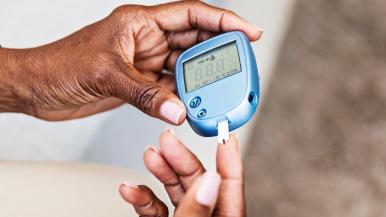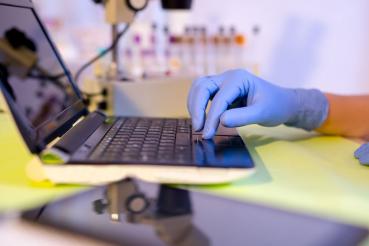When you hear the word "diabetes," you probably know that it has something to do with blood sugar and the need to take to insulin. But what you may not realize is that there are two types of diabetes — Type 1 and Type 2.
More often you’ll hear about Type 2 diabetes, which is more common and occurs when the body fails to produce enough insulin and also becomes insulin-resistant. This causes hyperglycemia or high blood sugar.
Less talked about is Type 1, an autoimmune disorder, which occurs because of antibodies that destroy your pancreatic beta cells. Without these pancreatic cells, the body can no longer produce insulin, which is why people with Type 1 diabetes are put on insulin.
"If you have Type 2 diabetes, you don't necessarily need to be on insulin," says Tiffany Hor, MD, an endocrinologist at Rush University Medical Center. "You'll usually be given pills first to lower your blood sugar. Sometimes the pills aren't adequate, and that's when you may need to start insulin. Type 1 diabetes is always insulin-dependent."
Here, Hor offers five other important facts about Type 1 diabetes.
1. Age is often — but not always — a key factor.
Generally, those with Type 1 diabetes are diagnosed during their childhood. In fact, Type 1 is frequently referred to as juvenile-onset diabetes. However, latent autoimmune diabetes in adults, or LADA, usually occurs after age 30 and is treated as Type 1.
There's a lack of consensus among experts, however, on whether LADA is actually Type 1. Sometimes it's even referred to as Type 1.5. The difference is that with Type 1 diabetes, insulin is needed almost immediately — within days or months of diagnosis. In adults with LADA, the progression of the disease occurs over a longer period of time so insulin may not be required for months or years.
2. Symptoms can appear suddenly.
Most patients find out they have Type 1 diabetes because they've developed symptoms over the course of only weeks or months.
Symptoms of type 1 diabetes include the following:
- Increased urination
- Increased thirst
- Blurred vision
- Weight loss
- Fatigue
Some people may also experience diabetic ketoacidosis, or DKA. "You get high ketone levels because you don't have enough insulin to process sugar," Hor says.
When there is not enough insulin to process sugar, your body begins to break down fat as a fuel source instead. Your liver converts fatty acids into chemicals called ketone bodies, which can cause your blood to become too acidic.
"This can lead to a host of symptoms. Dehydration is common, along with other symptoms including nausea, vomiting, abdominal pain, possibly confusion and a reduction in kidney function," Hor says.
3. There’s more than one way to get insulin.
Insulin is the main course of treatment for Type 1 diabetes. However, it can be administered in a variety of ways.
"The most common is giving insulin injections under the skin, which includes basal, or long-acting, insulin and prandial, or fast-acting, insulin," Hor says.
Basal insulin is what your body needs if you don’t eat carbohydrates, while prandial, which means "mealtime," is insulin you need when you eat carbohydrates. This quick-acting injection works within 10 to 15 minutes and is taken when eating a meal to counteract the effects of high blood sugar.
"It's a regimen that mimics what your pancreas does on a day-to-day basis, and you can tailor it to your lifestyle, so you can take it according to when you eat, when you work, etc. It gives you more flexibility," Hor says.
But injections aren't the only way to get insulin. An insulin pump worn on the body provides continuous infusions. A physician or health care professional programs the pump to determine how much insulin to give — both as a continuous infusion and according to the amount of carbs a person eats. Patients using these pumps need to prick their fingers to monitor sugar levels.
Another option: a continuous glucose monitor. Worn for one to two weeks at a time, this device features a tiny sensor — implanted under the skin — that senses blood sugar levels every 5 minutes. You must also do finger sticks to make sure the monitor is accurately sensing your levels.
"The continuous monitor is convenient for those who have brittle blood sugars, which means it fluctuates from high one minute and drops the next," Hor explains. "The monitor enables patients to see where their blood sugar is trending and proactively treat themselves before it gets to be too low or too high."
To best monitor your blood glucose, it's important to learn how different foods affect it and how to develop balanced, healthy meal plans that help support these levels on a daily basis.
4. Researchers are looking for a cure.
New research is exploring possible cures for Type 1 diabetes. Some experimental procedures seek to replace destroyed islet cells with transplanted healthy ones. Others are exploring artificial pancreas systems to monitor and automate blood sugar control in the body.
Researchers are also looking into screening newly diagnosed patients and their family members to detect and monitor Type 1 antibodies to see if they have a predisposition to the disease.
"There's also interest in immune modulators to delay progression or delay development of Type 1 diabetes," Hor adds. Immune modulators are chemicals that change how the body's immune system responds.
5. Managing Type 1 diabetes requires a holistic approach.
Although Type 1 diabetes can be a difficult disease to manage, it is possible with a combination of proper insulin management and the following:
- Blood sugar monitoring. Blood sugar control will require regular monitoring of your glucose levels and then properly administering insulin to maintain proper levels. Your health care team will help determine what type of insulin works best for you.
- Nutrition. To best monitor your blood glucose, it's important to learn how different foods affect it and how to develop balanced, healthy meal plans that help support these levels on a daily basis.
- Exercise. With regular exercise, your blood glucose levels can be better controlled. But it becomes important to understand how these levels will vary before, during and after intense activity so you can take the proper precautions in case levels rise or fall.
- Support. The learning curve can feel steep when managing Type 1 diabetes so emotional support is important as well. Connecting with others who are going through the same experience can help, and your healthcare team can link you up with support groups.
"With good patient education, good nutrition and lifestyle counseling, and with the expertise and support of a very dedicated healthcare team," Hor says, "patients with type 1 diabetes can live happy and healthy lives."




